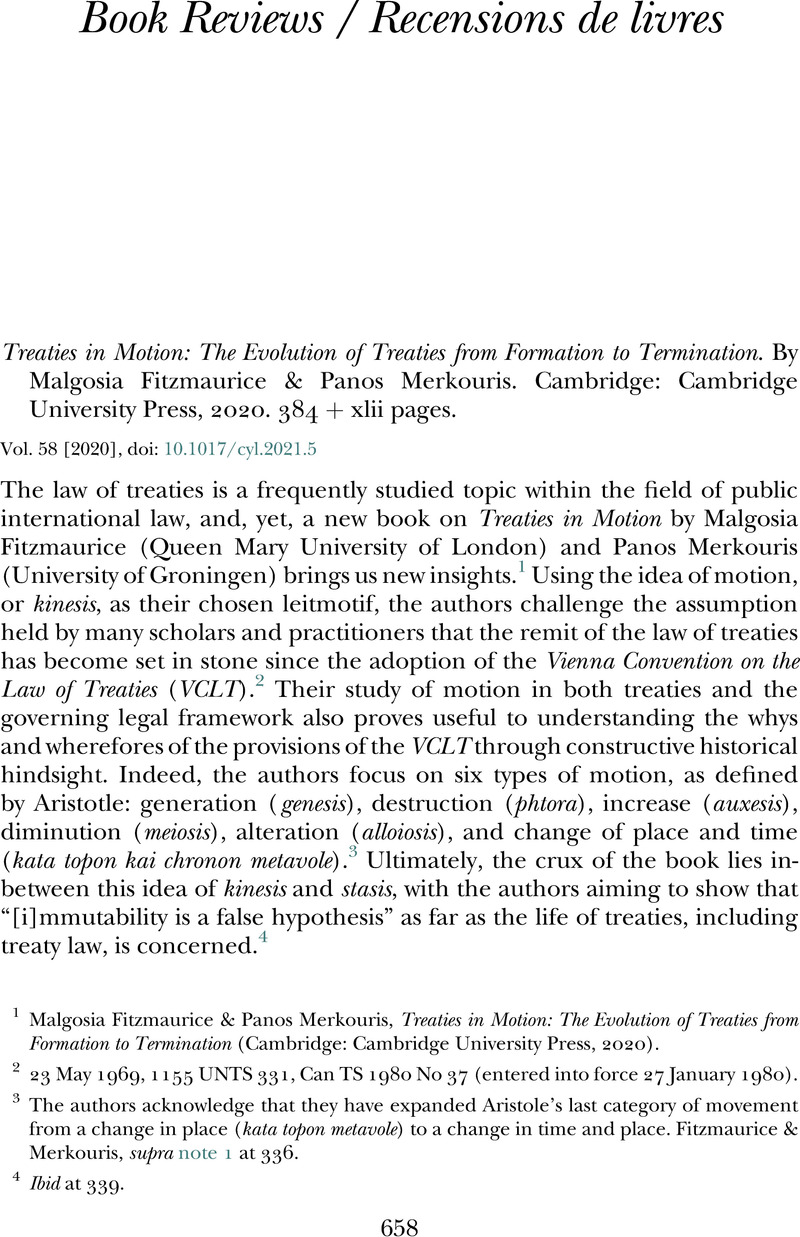No CrossRef data available.
Article contents
Treaties in Motion: The Evolution of Treaties from Formation to Termination. By Malgosia Fitzmaurice & Panos Merkouris. Cambridge: Cambridge University Press, 2020. 384 + xlii pages.
Review products
Published online by Cambridge University Press: 20 May 2021
Abstract

- Type
- Book Reviews/Recensions de livres
- Information
- Canadian Yearbook of International Law/Annuaire canadien de droit international , Volume 58 , November 2021 , pp. 658 - 662
- Copyright
- © The Canadian Yearbook of International Law/Annuaire canadien de droit international 2021
References
1 Malgosia, Fitzmaurice & Panos, Merkouris, Treaties in Motion: The Evolution of Treaties from Formation to Termination (Cambridge: Cambridge University Press, 2020)CrossRefGoogle Scholar.
2 23 May 1969, 1155 UNTS 331, Can TS 1980 No 37 (entered into force 27 January 1980).
3 The authors acknowledge that they have expanded Aristole’s last category of movement from a change in place (kata topon metavole) to a change in time and place. Fitzmaurice & Merkouris, supra note 1 at 336.
4 Ibid at 339.
5 Ibid at 169.
6 The authors also address revision, although they indicate that the International Law Commission (ILC) considered the difference between amendment and revision to be “artificial.” Ibid at 187.
7 See “Draft Articles on Responsibility of States for Internationally Wrongful Acts” in Report of the International Law Commission, UN GAOR, 56th Sess, Supp No 10, UN Doc. A/56/10 (2001) at 26–30.
8 To clearly distinguish alteration from increase and diminution, one might think of the dictum attributed (apocryphally) to Lavoisier: “Rien ne se perd, rien ne se crée, tout se transforme” (“nothing is lost, nothing is created, everything is transformed”). This is in fact a paraphrase of a longer passage found in Antoine-Laurent de Lavoisier, Traité élémentaire de chimie (Paris: Cuchet, 1789) at 140–41.
9 The motion of alteration seems to be the epitome of interpretation, a process through which the parties’ obligations should neither be increased nor diminished. See e.g. Understanding on Rules and Procedures Governing the Settlement of Disputes (Annex 2 to the Marrakesh Agreement Establishing the World Trade Organization), 15 April 1994, 1869 UNTS 401, art 3(2) (entered into force 1 January 1995), which states that Dispute Settlement Body recommendations and rulings “cannot add to or diminish the rights and obligations provided in the covered agreements.”
10 Island of Palmas Case (Netherlands v United States) (1928), 2 RIAA 829.
11 Fitzmaurice & Merkouris, supra note 1 at 193.


